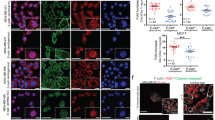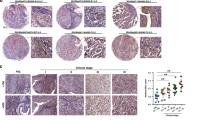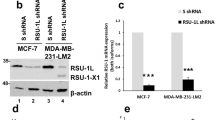Abstract
Novel N-cadherin expression has been linked to the invasive phenotype in bladder tumors yet a primary role for N-cadherin in invasion has not been defined in this model. To address this, N-cadherin was stably transfected into E-cadherin expressing bladder carcinoma cells. This resulted in an enhanced invasive capacity in in vitro assays that was blocked by incubation with an N-cadherin function-blocking antibody in a dose-dependent manner. Analysis of the signaling pathway(s) implicated in N-cadherin-mediated invasion in bladder carcinoma cell lines revealed no correlation between MAPK signaling and invasion, in the presence or absence of fibroblast growth factor 2. Also, while MAPK and p38 kinase inhibitors did not alter the invasive behavior of these cells, an increase in the phosphorylation of Akt at serine-473 was detected in N-cadherin transfectants, suggestive of N-cadherin-mediated Akt activation in bladder cell invasion. Incubation of N-cadherin transfectants with either PI3 kinase or Akt inhibitors resulted in a significant decrease in the invasive capacity of these cells. Exposure of cells to PP2, a src family kinase inhibitor, also decreased the invasive potential of N-cadherin transfectants and resulted in reduced phosphorylation of Akt. The involvement of Akt signaling in bladder cell invasion was also supported by the inhibition of bladder cell invasion by cells constitutively expressing an activated Akt kinase, using the PI3 kinase and Akt inhibitors and PP2. These results suggest that activation of PI3/AKT kinase following N-cadherin expression contributes to the increased invasive potential of bladder carcinoma cells.
This is a preview of subscription content, access via your institution
Access options
Subscribe to this journal
Receive 50 print issues and online access
$259.00 per year
only $5.18 per issue
Buy this article
- Purchase on Springer Link
- Instant access to full article PDF
Prices may be subject to local taxes which are calculated during checkout







Similar content being viewed by others
References
Arboleda MJ, Lyons JF, Kabbinavar FF, Bray MR, Snow BE, Ayala DM, Karlan BY and Slamon DJ . (2003). Cancer Res., 63, 196–206.
Bringuier JI, Umbas R, Schaafsma HE, Karthaus HFM, Debruyne FMJ and Schalken JA . (1993). Cancer Res., 53, 3241–3245.
Bussemakers MJG, Van Bokhoven A, Tomita K, Jansen CFJ and Schalken JA . (2000). Int. J. Cancer, 85, 446–450.
Cartwright CA, Kamps MP, Meisler AI, Pipas JM and Eckhart W . (1989). J. Clin. Invest., 83, 2025–2033.
Cartwright CA, Meisler AI and Eckhart W . (1990). Proc. Natl. Acad. Sci. USA, 87, 558–562.
Chang L and Karin M . (2001). Nature, 410, 37–40.
Chen R, Kim O, Yang J, Sato K, Eisenmann KM, McCarthy J, Chen H and Qiu Y . (2001). J. Biol. Chem., 276, 31858–31862.
Fanning P, Bulovas K, Saini KS, Libertino JA, Joyce AD and Summerhayes IC . (1992). Cancer Res., 52, 1457–1462.
Frixen UH, Behrens J, Sachs M, Eberle G, Voss B, Warda A, Lochner D and Birchmeier W . (1991). J. Cell Biol., 113, 173–185.
Gee J, Greathead P, Little AF, Libertino JA and Summerhayes IC . (1998). Mol. Urol., 2, 73–81.
Giroldi LA, Bringuier P, Shimazu T, Janssen K and Schalken JA . (1999). Int. J. Cancer, 82, 70–76.
Grille SJ, Bellacosa A, Upson J, Klein-Szanto AJ, Van Roy F, Lee-Kwon W, Donowitz M, Tschilis PN and Larue L . (2003). Cancer Res., 63, 2172–2178.
Hazan RB, Kang L, Whooley BP and Borgen PI . (1997). Cell Adhes. Commun., 4, 399–411.
Hazan RB, Phillips GR, Qiao RF, Norton L and Aaronson SA . (2000). J. Cell Biol., 148, 779–790.
Hong RI, Pu YS, Heish TS, Chu JS and Lee WJ . (1995). J. Urol., 153, 2025–2028.
Hsu MY, Wheelock MJ, Johnson KR and Herlyn M . (1996). J. Invest. Dermatol. Symp. Proc., 1, 188–194.
Islam S, Carey TE, Wolf GT, Wheelock MJ and Johnson KR . (1996). J. Cell Biol., 135, 1643–1654.
Kawakita M, Moroi S, Kyotani K, Kakehi Y and Yoshida O . (1994). Acta Urol. Jpn., 40, 1077–1080.
Kim D, Kim S, Koh H, Yoon SO, Chung AS, Cho KS and Chung J . (2001). FASEB J., 15, 1953–1962.
Levenberg S, Katz B-Z, Yamada KM and Geiger B . (1998). J. Cell Sci., 111, 347–357.
Li G, Satyamoorthy K and Herlyn M . (2001). Cancer Res., 61, 3819–3825.
Lipponen PK and Eskelinen MJ . (1995). J. Cancer Res. Clin. Oncol., 121, 303–308.
Lu Y, Yu Q, Liu JH, Zhang J, Wang H, Koul D, McMurray JS, Fang X, Yung WK, Siminovitch KA and Mills GB . (2003). J. Biol. Chem., 278, 40057–40066.
Mialhe A, Louis J, Pasquier D, Rambeaud J-J and Seigneurin D . (1997). Anal. Cell. Path., 13, 125–136.
Miyazaki J, Fujisawa M, Arakawa S and Kamidono S . (1995). Jpn. J. Urol., 86, 1208–1215.
Nieman MT, Prudoff RS, Johnson KR and Wheelock MJ . (1999). J. Cell Biol., 147, 631–643.
Paez JG and Sellers WR . (2003). Cancer Treat. Res., 115, 145–167.
Rieger-Christ KM, Cain JW, Braasch JW, Dugan JM, Silverman ML, Bouyounes B, Libertino JA and Summerhayes IC . (2001). Hum. Pathol., 32, 18–23.
Sanders DS, Blessing K, Hassan GA, Bruton R, Marsden JR and Jankowski J . (1999). Mol. Pathol., 52, 151–157.
Sotsios Y and Ward SG . (2000). Immunol. Rev., 177, 217–235.
Suyama K, Shapiro I Guttman M and Hazan RB . (2002). Cancer Cell, 2, 301–314.
Talamonti MS, Roh MS, Curley SA and Gallick GE . (1993). J. Clin. Invest., 91, 53–60.
Testa JR and Bellacosa A . (2001). Proc. Natl. Acad. Sci. USA, 98, 10983–10985.
Thant AA, Nawa A, Kikkawa F, Ichigotani Y, Zhang Y, Sein TT, Amin AR and Hamaguchi M . (2000). Clin. Exp. Metast., 18, 423–428.
Tomita K, van Bokhoven A, van Leenders GJ, Ruijter ET, Jansen CF, Bussemakers MJ and Schalken JA . (2000). Cancer Res., 60, 3650–3654.
Tran NL, Adams DG, Vaillancourt RR and Heimark RL . (2002). J. Biol. Chem., 277, 32905–32914.
Vleminckx K, Cakaet Jr L, Mareel M, Fiers W and van Roy F . (1991). Cell, 66, 107–119.
Wang DS, Rieger-Christ KM, Latini JM, Moinzadeh A, Stoffel J, Pezza JA, Saini K, Libertino JA and Summerhayes IC . (2000). Int. J. Cancer, 88, 620–625.
Westermarck J and Kahari VM . (1999). FASEB J., 13, 781–792.
Acknowledgements
Alireza Moinzadeh and Ralph Zagha are Robert E Wise Research Fellows. We thank M Wheelock and K Johnson for reagents. This work was supported by NIH Grant 1DK59400. Work in A B-Z's laboratory was supported by the Israel Cancer Research Foundation and by the German Israeli Foundation for Scientific Research and Development.
Author information
Authors and Affiliations
Corresponding author
Rights and permissions
About this article
Cite this article
Rieger-Christ, K., Lee, P., Zagha, R. et al. Novel expression of N-cadherin elicits in vitro bladder cell invasion via the Akt signaling pathway. Oncogene 23, 4745–4753 (2004). https://doi.org/10.1038/sj.onc.1207629
Received:
Revised:
Accepted:
Published:
Issue Date:
DOI: https://doi.org/10.1038/sj.onc.1207629
Keywords
This article is cited by
-
Enhanced cell–cell contact stability and decreased N-cadherin-mediated migration upon fibroblast growth factor receptor-N-cadherin cross talk
Oncogene (2019)
-
EC4, a truncation of soluble N-cadherin, reduces vascular smooth muscle cell apoptosis and markers of atherosclerotic plaque instability
Molecular Therapy - Methods & Clinical Development (2014)
-
TRPM8 promotes aggressiveness of breast cancer cells by regulating EMT via activating AKT/GSK-3β pathway
Tumor Biology (2014)
-
PIK3CA mutation spectrum in urothelial carcinoma reflects cell context-dependent signaling and phenotypic outputs
Oncogene (2013)
-
N-cadherin Determines Individual Variations in the Therapeutic Efficacy of Human Umbilical Cord Blood-derived Mesenchymal Stem Cells in a Rat Model of Myocardial Infarction
Molecular Therapy (2012)



